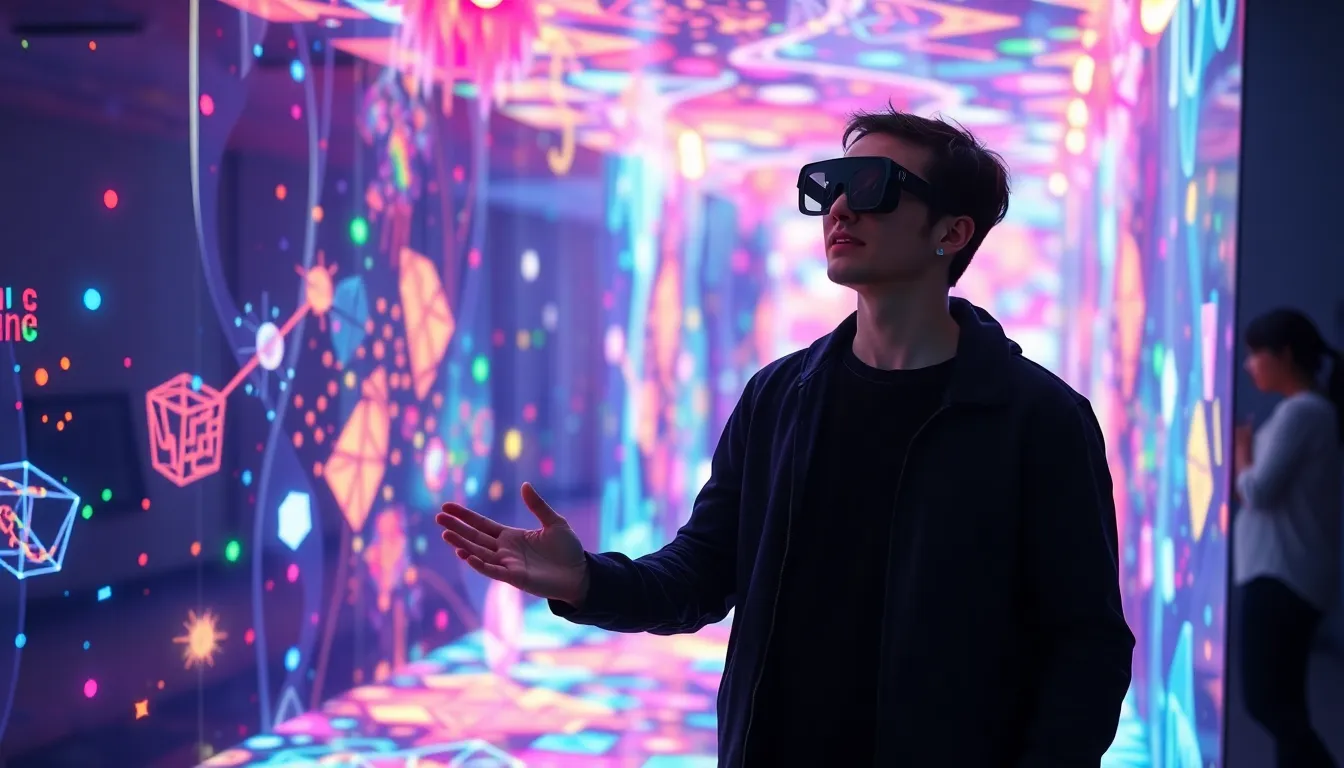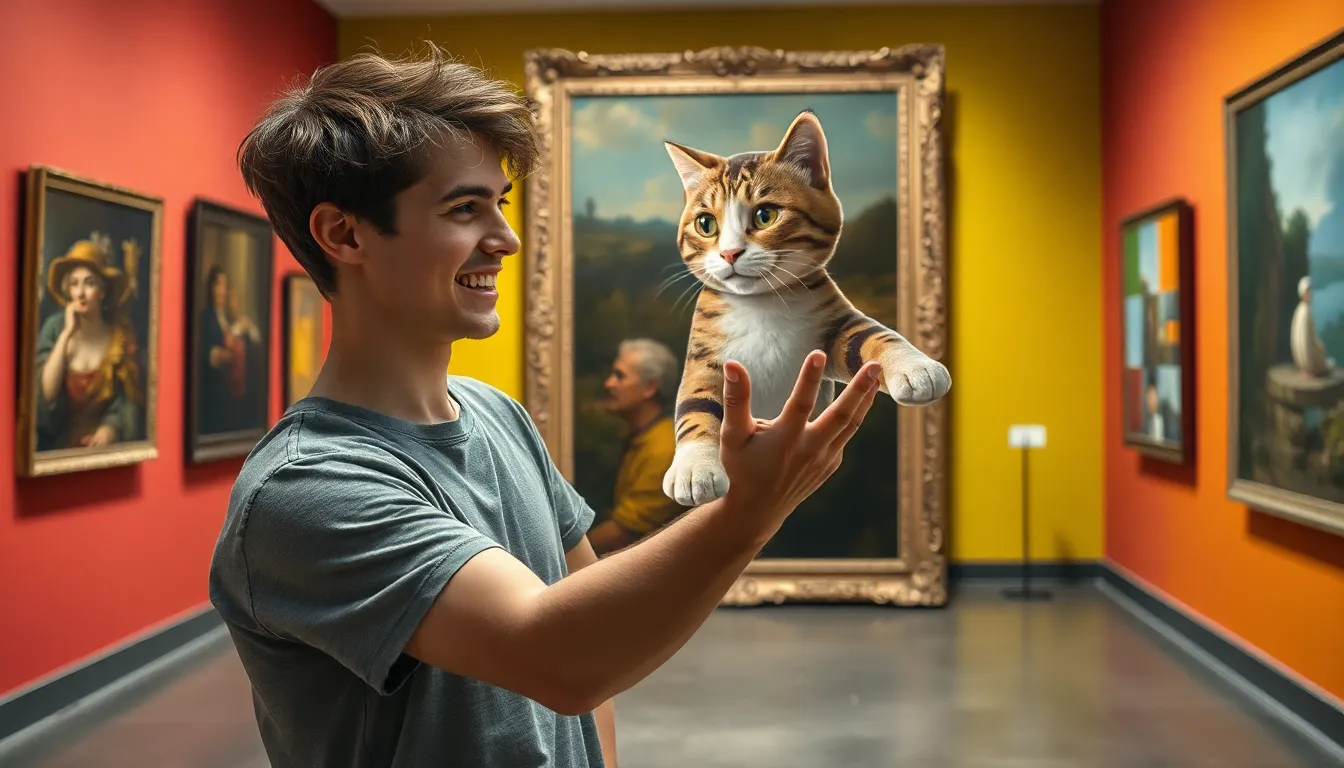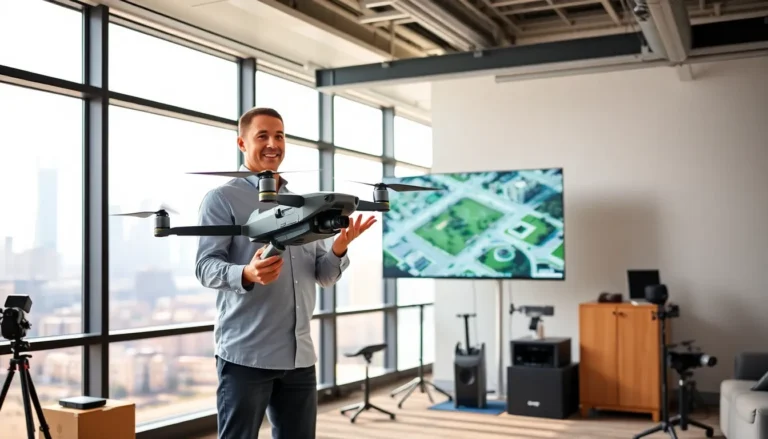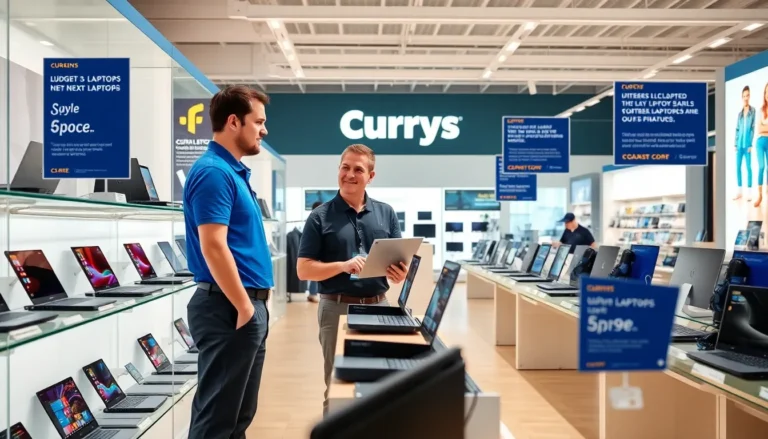Imagine strolling through a gallery where the paintings come alive, dancing and telling stories right before your eyes. That’s the magic of augmented reality art. This innovative fusion of technology and creativity transforms static images into immersive experiences, making art not just something to look at but something to interact with.
In a world where selfies reign supreme, augmented reality art offers a fresh twist, turning every corner into a potential masterpiece. Who wouldn’t want to snap a pic with a giant, virtual cat lounging on a famous canvas? As artists embrace this cutting-edge medium, they’re not just breaking the mold—they’re shattering it. Join the revolution and discover how augmented reality art is reshaping the way we experience creativity, one digital brushstroke at a time.
Table of Contents
ToggleOverview of Augmented Reality Art
Augmented reality art blends digital elements with physical environments, offering immersive experiences. Artists utilize technology to transform static artworks into engaging, interactive pieces. This approach not only captivates audiences but also invites them to actively participate in the art-making process.
Viewers can interact with digital overlays in real time, enhancing their understanding of the artwork. For example, a painting may come alive with animated visuals or soundscapes that enhance the narrative. Such interactions help create deeper emotional connections between the audience and the artwork.
Exhibitions incorporating augmented reality art are appearing in galleries and public spaces worldwide. Many contemporary artists integrate apps that allow viewers to explore hidden layers within their works. This innovation encourages exploration and a fresh perspective on traditional mediums like painting and sculpture.
Social media plays a significant role in the popularity of augmented reality art. Shareable virtual experiences attract attention and engagement, making art more accessible. Consequently, artists choose to leverage platforms like Instagram and Snapchat for showcasing their augmented reality projects, inviting global audiences to participate in their creative journeys.
Current technology advancements also expand the realm of possibilities for artists. High-quality graphics and mobile devices contribute to smoother interactions, enhancing the overall experience. As more creators experiment with this medium, the future of augmented reality art promises to be dynamic and transformative, pushing the boundaries of what art can achieve.
Key Features of Augmented Reality Art

Augmented reality art incorporates innovative features that enhance viewer engagement and interaction. This medium allows for unique ways to experience traditional art forms.
Immersive Experiences
Immersion in augmented reality art creates a three-dimensional environment. Viewers step into dynamic scenes, finding themselves surrounded by digital creations. Artists design these experiences to evoke strong emotional responses, capturing attention effectively. Spatial audio and visual effects further enhance these immersive settings, making viewers feel part of the artwork. Real-time interaction promotes deeper connections as viewers explore the evolving landscapes of digital art.
Interactive Elements
Interaction thrives in augmented reality art, encouraging participation from viewers. Engaging with digital overlays, audiences manipulate elements through gestures or movements. This interaction fosters personal interpretations, transforming passive observation into active involvement. Artists utilize accessible apps to enable seamless interactions, allowing viewers to unlock hidden layers or animations. This process not only deepens the appreciation for the artwork but also invites collaboration between the artist and the audience, creating a shared creative experience.
Popular Augmented Reality Art Projects
Augmented reality art projects continue to gain traction, highlighting the intersection of technology and creativity.
Notable Artists in the Field
Prominent artists shape the augmented reality art landscape. KAWS, known for his playful characters, integrates AR into his exhibitions, inviting viewers to engage with his iconic imagery. Takashi Murakami also explores this medium, blending traditional Japanese art with digital technology to create immersive experiences. Moreover, Olafur Eliasson employs AR to transform public spaces, encouraging interaction with his large-scale installations. These artists exemplify how innovation enhances creative expression.
Successful Installations and Exhibitions
Various installations and exhibitions showcase the power of augmented reality. The Museum of Modern Art, for example, features projects that merge digital overlays with classic artworks, enabling visitors to experience familiar pieces in new ways. TeamLab Borderless in Tokyo presents a groundbreaking exhibition where art flows continuously between rooms, each piece responding to viewer movements. Another notable example, the “AR Museum” in Amsterdam, invites guests to explore art through their smartphones, revealing hidden narratives within the artworks. These successful projects highlight the transformative nature of augmented reality in art.
Benefits of Augmented Reality Art
Augmented reality art presents unique advantages that enhance both artwork and viewer experiences. This medium actively engages audiences, inviting interaction and emotional connection.
Enhancing Audience Engagement
Audience engagement significantly improves through interactive experiences offered by augmented reality. Spectators connect more deeply with the artwork, as they can manipulate digital elements using gestures. Immersive qualities allow viewers to feel part of the art, transforming passive observation into active participation. Artists design engaging experiences that resonate, creating unforgettable moments shared among viewers. Emotional responses often heighten, making each interaction memorable and personal. The introduction of spatial audio effects invites listeners into a three-dimensional world, further enriching the experience. As a result, augmented reality becomes a powerful tool for fostering community and collaboration around art.
Bridging Digital and Physical Worlds
Augmented reality art seamlessly blends digital and physical environments, creating a comprehensive artistic experience. By superimposing digital elements onto physical canvases, this form of art invites exploration beyond traditional mediums. Viewers discover layers they might otherwise miss, encouraging unexpected interpretations. Contemporary installations utilize mobile devices and apps to enhance accessibility, allowing audiences to engage on their terms. Innovative projects at renowned locations facilitate collaboration between artists and spectators, bridging the gap between real and virtual realms. Traditional galleries now host dynamic displays, ensuring that art evolves to meet the demands of a tech-savvy society. This integration represents a profound shift in how art is experienced and understood.
Challenges in Augmented Reality Art
Augmented reality art faces several challenges that artists and developers must navigate.
Technical Limitations
Technical limitations pose significant obstacles for creators in this field. Devices often lack the computational power needed for complex AR experiences. Besides that, inconsistencies in software can lead to performance issues across various platforms. Users may also encounter difficulties due to varying device compatibility. Lasting issues with latency disrupt the fluidity of interactions, creating a gap between the digital and physical worlds. While these limitations exist, ongoing advances in technology promise to diminish them over time.
Artistic Considerations
Artistic considerations play a crucial role in developing augmented reality art. Artists must balance the integration of digital elements with traditional artistic techniques. Engaging audiences requires a clear focus on emotional impact without overwhelming them with content. Careful selection of themes and narratives becomes essential for maintaining viewer interest. Certain works may challenge established artistic norms, prompting debates on the definition of art itself. Artists also face the risk of alienating traditionalists who may view AR as gimmicky or superficial. Creating a seamless blend of creativity and technology remains a pressing priority for successful AR projects.
Augmented reality art is reshaping the landscape of creativity and viewer engagement. By fusing digital elements with traditional art forms, it invites audiences to partake in immersive experiences that evoke emotional connections. This innovative medium not only enhances accessibility but also fosters a sense of community among artists and viewers.
As technology continues to evolve, so will the possibilities within augmented reality art. Creators are poised to explore new dimensions of expression while addressing the challenges that come with this integration. The future of AR art promises to be dynamic and transformative, offering exciting opportunities for both artists and audiences alike.





